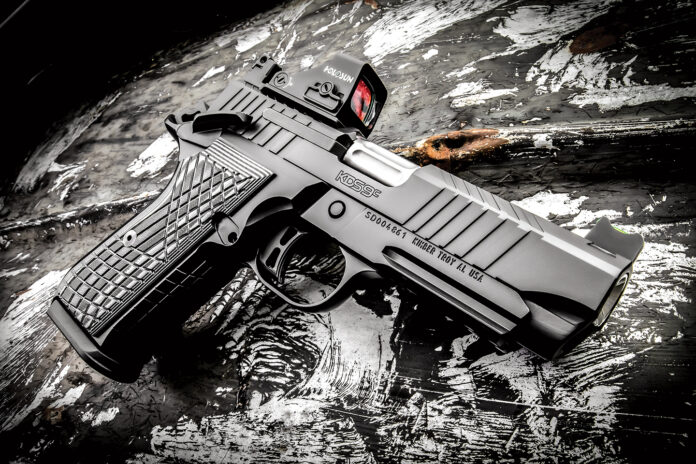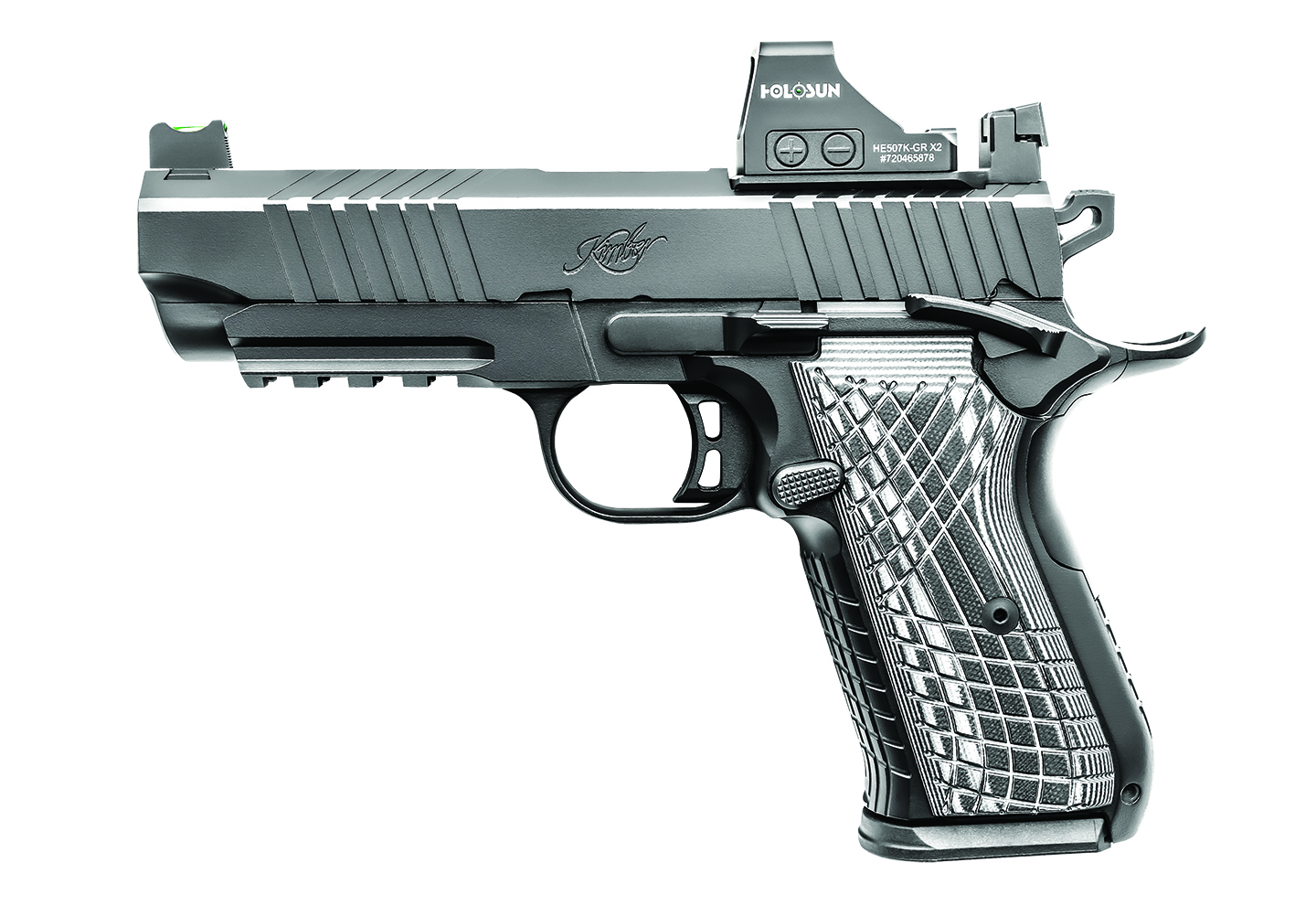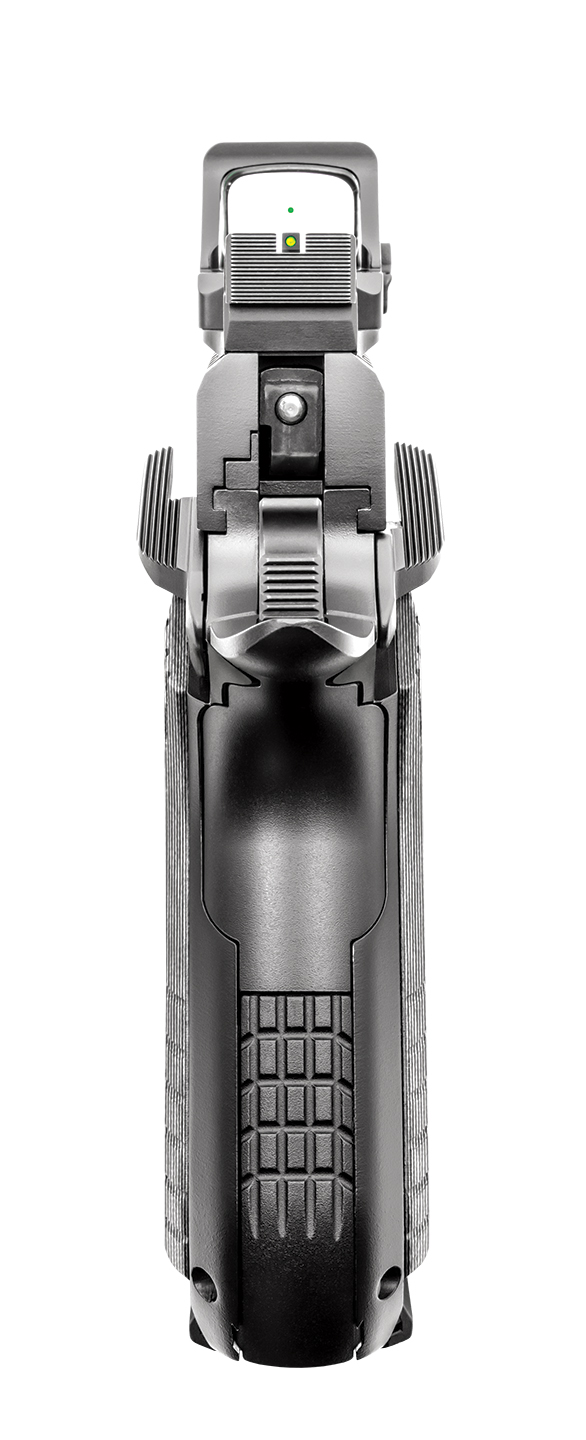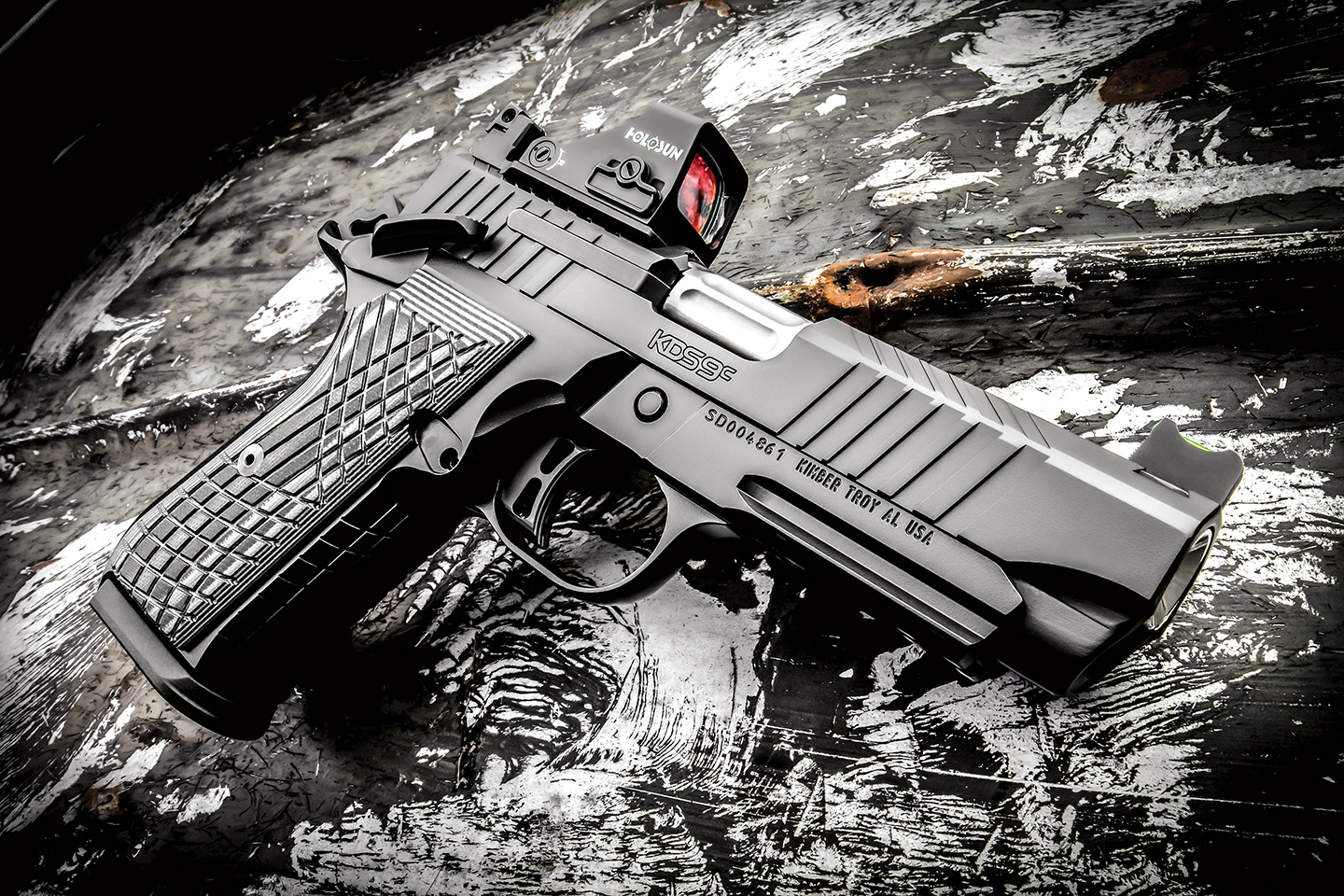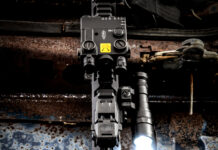Kimber KDS9c
By Massad Ayoob
Kimber’s entry into the double-stack 9mm 1911 carry market, now railed and ambi
The pistol is locked out one-handed, tilted fifteen degrees inboard in the technique popularized by the late, great champions Bill McMillan and Ray Chapman. The bright green dot in the optical sight window dances in the middle of the target as you work the trigger as fast as you can. By the time fifteen spent 9mm casings are on the ground, the dot has not left the target.
You are shooting the Kimber KDS9c with a Holosun 507k optic, and you have found it quite shootable indeed.
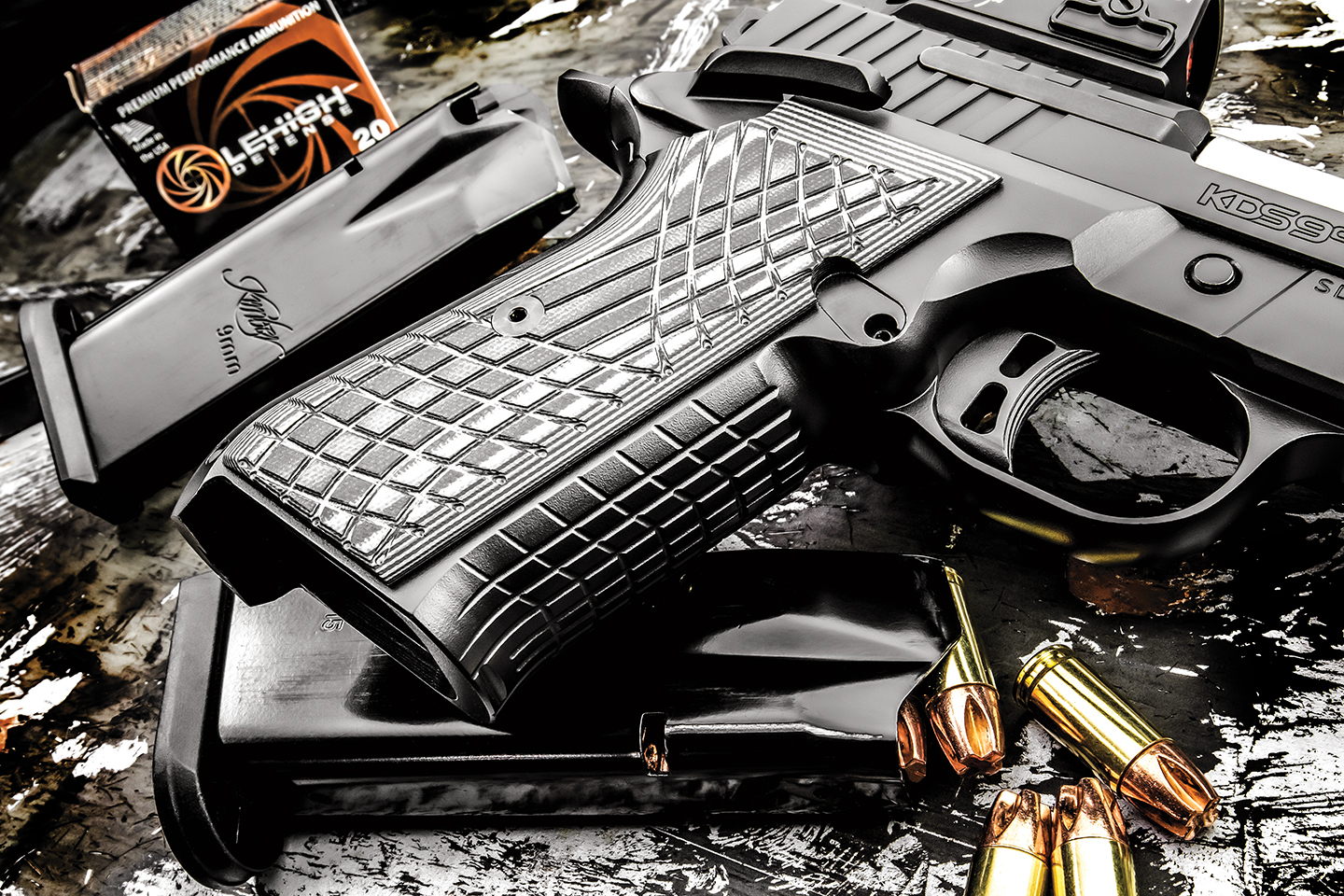
Overview
Firearms design is derivative. How far back do modern double-barrel shotguns harken? How many 1911 pistols (including the one under discussion here) sit newly made in dealers’ showcases? On the polymer 9mm pistol shelf, you’ll see real Glock 19s flanked by “mock 19s.” Copies of John Moses Browning’s 1911 and 1935 designs abound, with Kimber having built its reputation on the former. The Kimber Double Stack 9mm compact looks remarkably like the Wilson Combat EDC X9 series, which does not seem to have escaped the attention of a single reviewer. When On Target asked him about this, Kimber’s director of marketing, Everett Deger II, replied diplomatically, “Reviewers who note the comparison to a Wilson EDC X9 have good taste in firearms, and such attributes are shared by great quality manufacturers.”
The KSD9c’s fifteen and eighteen-round magazines are proprietary and not interchangeable with the Wilson Combat EDC series. We found the two provided mags easy to load all the way up, by hand, and to insert into the pistol with the slide in battery. The oversized magazine release made speed reloads a snap and it can be swapped to the right-hand side for southpaws.
Our KDS9c did have some sharp edges: around the front of the slide, for example, the front edges of the light rail, and on the shelves of the ambidextrous thumb safety levers. The grasping grooves – front, rear, and even top sides of the slide – were not particularly aggressive. The same was true of the G10 grips, which felt a little “fat” to me, but of course, that’s subjective.
Like the Wilson series it appears to be cloned from, the KDS9c does not have a grip safety. This is good news for those who like to shoot this type of pistol with their thumb riding the safety, which tends to pull the web of the hand back away from the grip safety and cause a failure to fire.
The barrel is coned and fluted and locked up well. The muzzle has an unusually deep crown, about twenty degrees, as opposed to the more common eleven-degree “dish.”
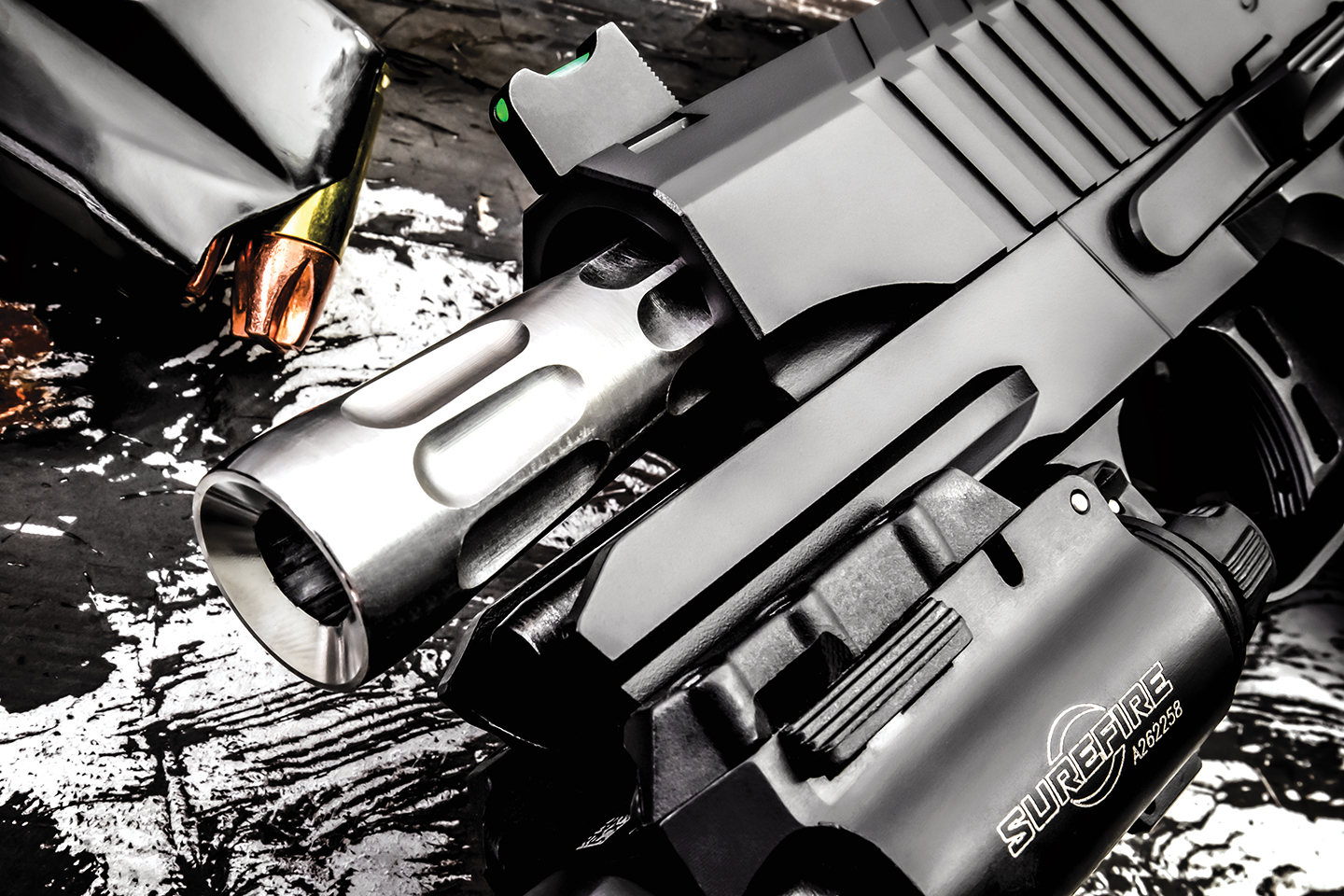
Trigger
Trigger pull is one of the selling points of the 1911 concept. Our KDS9c test sample, serial number SD004861, had a very short take-up followed by a smooth, clean break with no perceptible backlash. Other reviewers of very early samples occasionally reported glitches in the trigger pull; we did not experience that with ours. On a Lyman digital gauge, the trigger pull averaged four pounds six ounces, well within generally accepted specs for single-action “street” triggers. The reset was relatively short.
Not all pistols are drop-safe. Is the KDS9c? Mr. Deger told On Target, “This firearm adheres to SAAMI Specifications for Drop Testing, which is done by the Kimber engineering staff.”
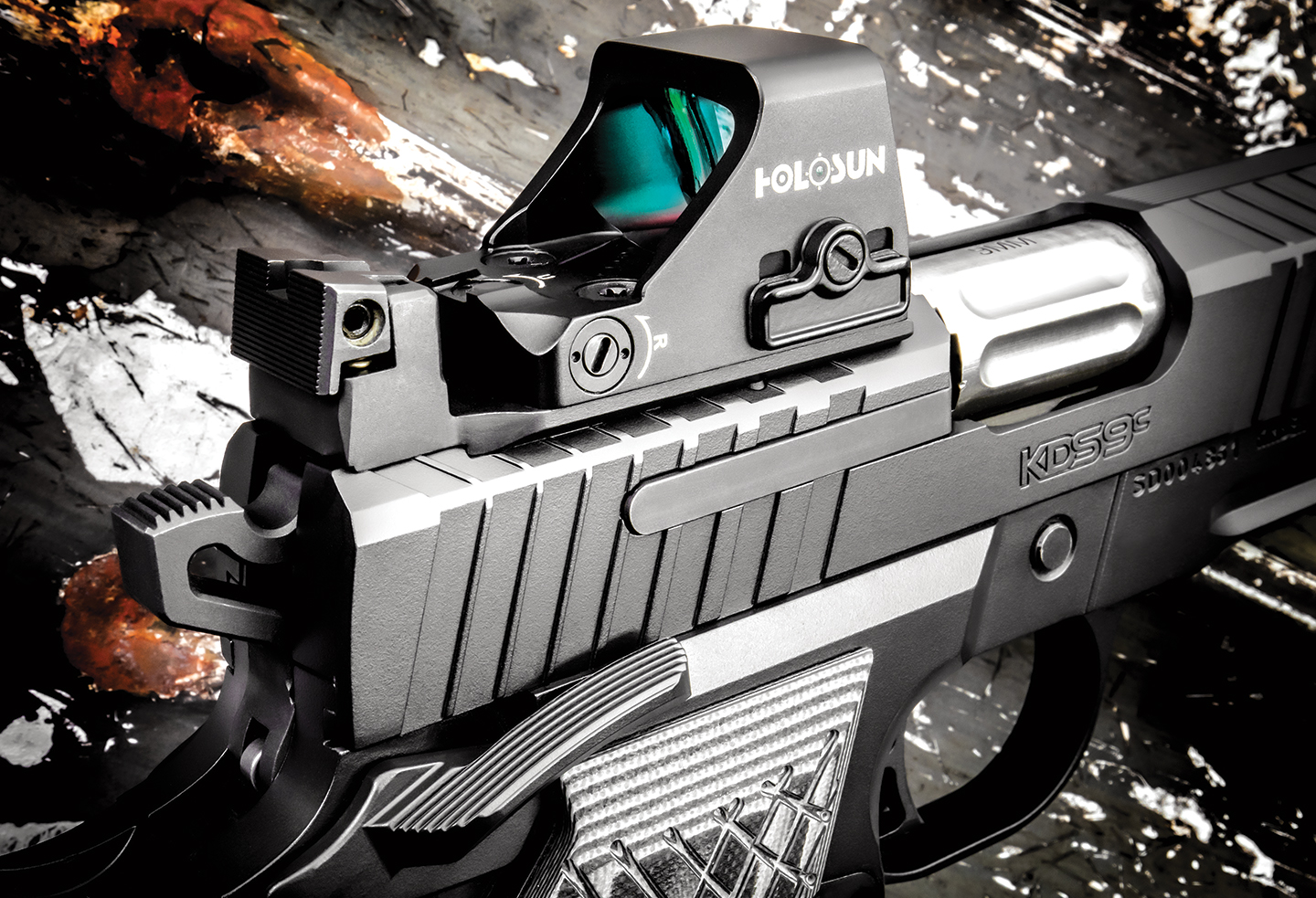
Sights
Our KDS9c came with suppressor-height sights adjustable for elevation and a green fiber optic front. They had been sighted in at the factory and were “dead-nuts on” at 25 yards. The pistol also came to us wearing a green dot Holosun 507K optical sight. The latter had yet to be sighted in and sent the bullets about seven inches low and five inches left from point of aim at 25 yards. Fortunately, Holosuns are adjustable, so it wasn’t a biggie.
Heft
Given its aluminum frame and steel top end, it’s fair to say that if you’ve carried a lightweight Colt Commander with 8+1 rounds of .45 ACP, you’ve already pretty much carried a KDS9c loaded with 15+1 rounds of 9mm. Of course, the grip frame is fatter on this double-stack gun, and the 9mm recoil is extremely mild and easy to control, even in one-handed rapid fire with arthritic hands.
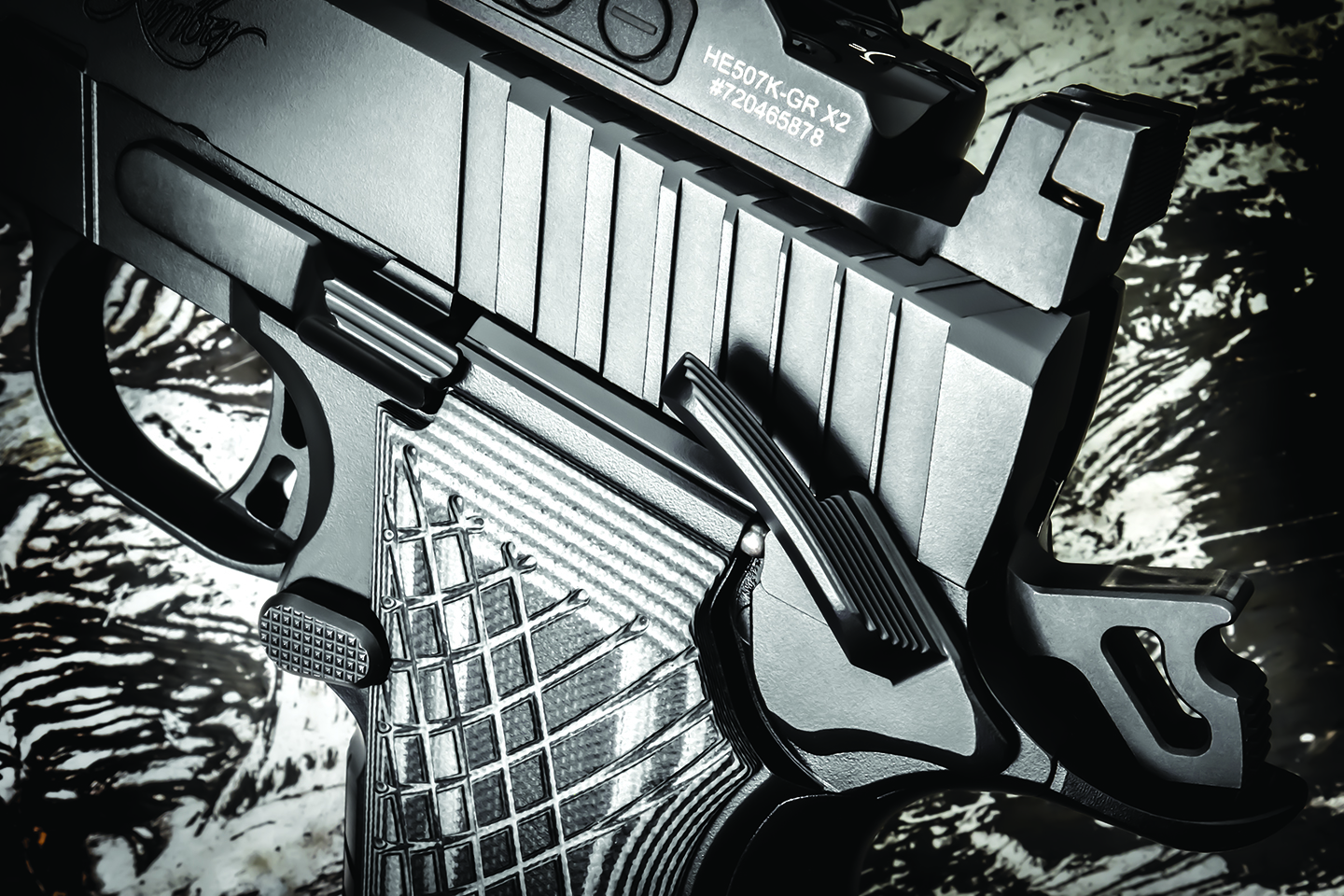
Reliability
We put several hundred rounds through our test Kimber. The ideal protocol is for the buyer to strip, clean, and lube the pistol before the first shots. However, most gun buyers don’t do that, so I don’t either: I want to know if it will work out of the box. This one did. No malfunctions of any kind. Some testers on YouTube report a thousand or more rounds fired with no issues.
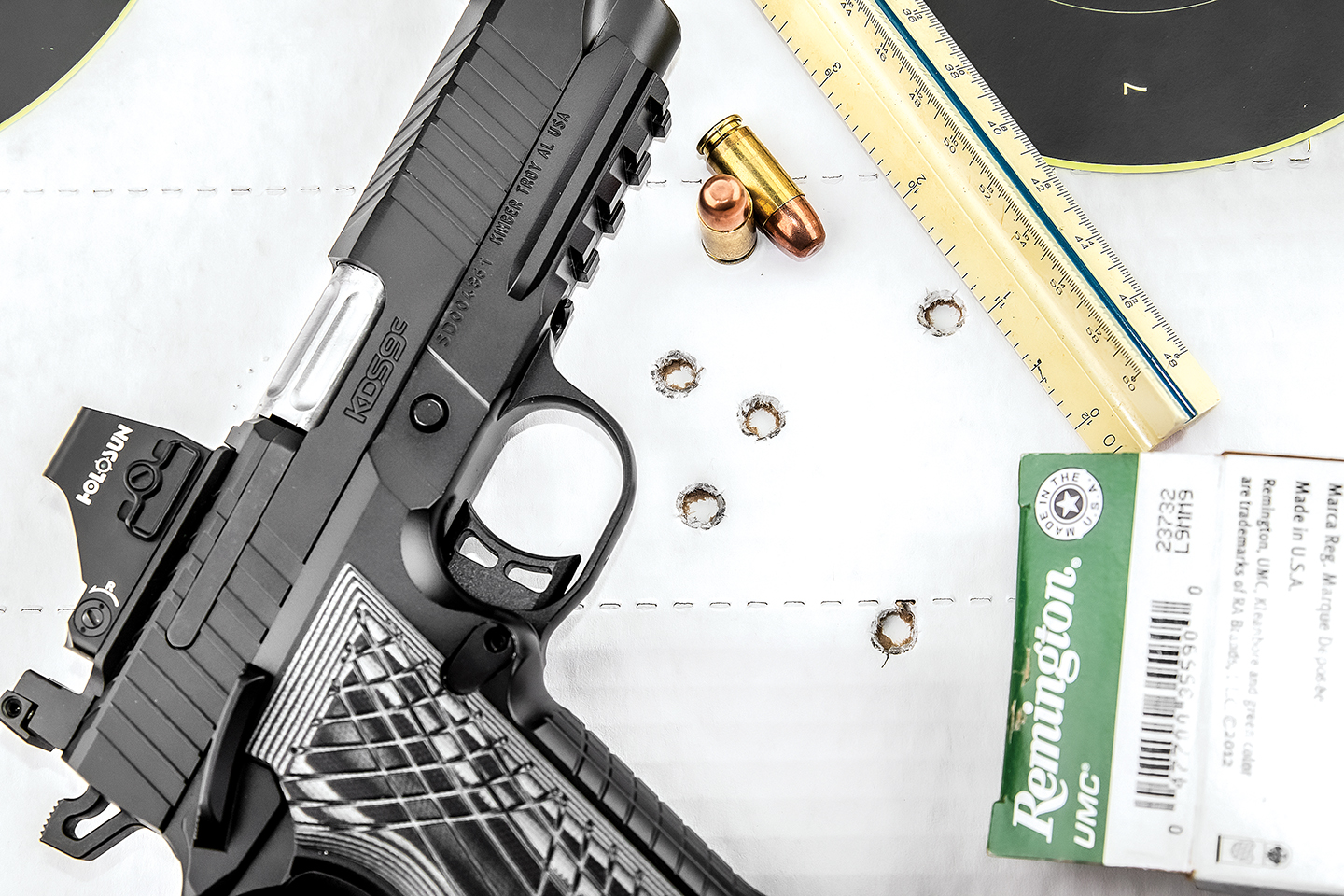
Accuracy
I followed my usual accuracy testing protocol, one that’s easy for readers to duplicate with their own samples of the same handguns: 25 yards on a Caldwell Matrix rest with each five-shot group measured once overall center-to-center of the farthest apart bullet holes, and again for the best three. The five-shot group predicts practical accuracy under ideal shooting conditions in experienced hands, and the “best three” is a proven predictor of what all five would be likely to do from a machine rest.
147 grain subsonic is a very popular 9mm load in the US and Canada. It was tested here with Remington-UMC jacketed truncated cone ammo from a production lot known to win pistol matches. The overall group size was 2.30″ (measured to the nearest 0.05″), and the best three, a more impressive 0.95″.
124 grain SIG V-Crown JHP did 3.55″ for all five and 1.85″ for the best three. Federal’s classic standard velocity 9BP, a 115-grain JHP, lived up to its reputation for accuracy with all five in 2.35” and the best three in 1.05”.
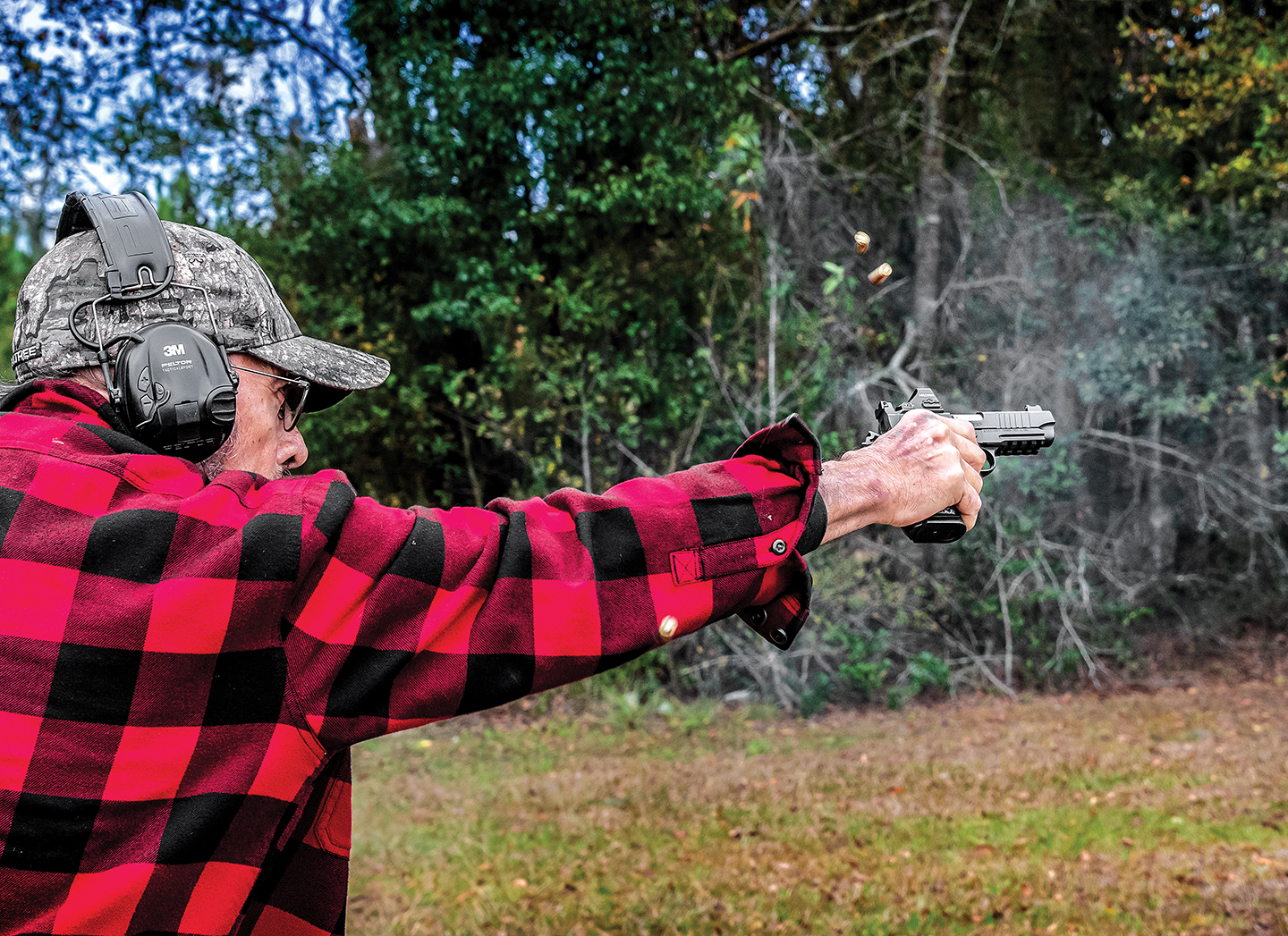
Bottom Line
Comparison of the KDS9c to the Wilson EDC series is obviously inescapable. Respected gun expert Keith Wood may have said it best when he wrote in Guns & Ammo, “Enthusiasts will no doubt compare the Kimber KDS9c to the Wilson Combat EDC X9, with good reason. Both guns combine 1911-style controls with a wide-body aluminum frame and a dual-column magazine. The dimensions and styling are nearly identical, though the Kimber is 5 ounces lighter. Handling the KDS9c next to my personal Wilson, I believe the latter to be a more refined handgun. This should be expected since it costs more than double the Kimber. A fair conclusion would be to say that the KDS9c is more of a feature-rich production handgun, while the Wilson Combat is a “premium semi-custom pistol.”
My own impression? The Kimber is half the price of the Wilson and more than half as good, which makes it a good value in its price range, which starts in the $1500 range. See the KDS9c at your nearest dealer, or for more information, contact Kimber; Tel.: (888) 243-4522; E-mail: [email protected]; Web: www.kimberamerica.com
SPECIFICATIONS:
Action: Single action
Caliber: 9mm
Barrel Length: 4.09 inches
Weight: 29.60 ounces
Finish: KimPro Black
Capacity: 15+1 and 18+1 rounds
MSRP: $1,495 to $1,903
















